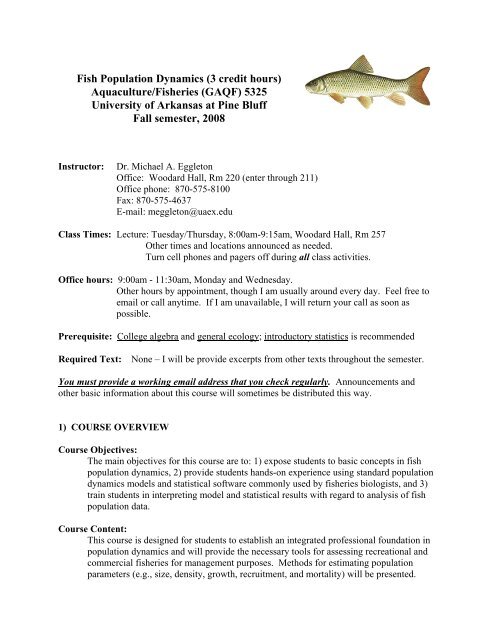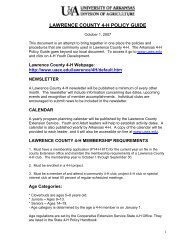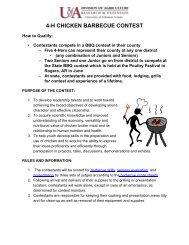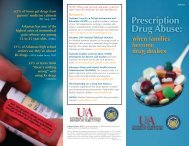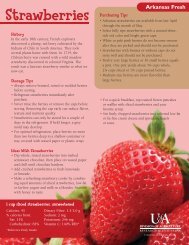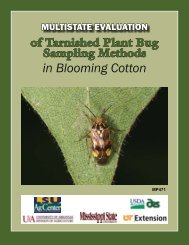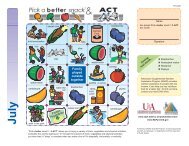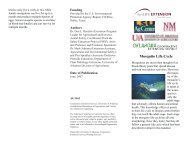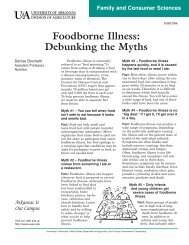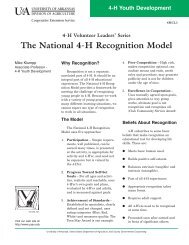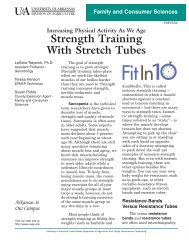Fish Population Dynamics - University of Arkansas Cooperative ...
Fish Population Dynamics - University of Arkansas Cooperative ...
Fish Population Dynamics - University of Arkansas Cooperative ...
You also want an ePaper? Increase the reach of your titles
YUMPU automatically turns print PDFs into web optimized ePapers that Google loves.
<strong>Fish</strong> <strong>Population</strong> <strong>Dynamics</strong> (3 credit hours)<br />
Aquaculture/<strong>Fish</strong>eries (GAQF) 5325<br />
<strong>University</strong> <strong>of</strong> <strong>Arkansas</strong> at Pine Bluff<br />
Fall semester, 2008<br />
Instructor:<br />
Dr. Michael A. Eggleton<br />
Office: Woodard Hall, Rm 220 (enter through 211)<br />
Office phone: 870-575-8100<br />
Fax: 870-575-4637<br />
E-mail: meggleton@uaex.edu<br />
Class Times: Lecture: Tuesday/Thursday, 8:00am-9:15am, Woodard Hall, Rm 257<br />
Other times and locations announced as needed.<br />
Turn cell phones and pagers <strong>of</strong>f during all class activities.<br />
Office hours: 9:00am - 11:30am, Monday and Wednesday.<br />
Other hours by appointment, though I am usually around every day. Feel free to<br />
email or call anytime. If I am unavailable, I will return your call as soon as<br />
possible.<br />
Prerequisite: College algebra and general ecology; introductory statistics is recommended<br />
Required Text: None – I will be provide excerpts from other texts throughout the semester.<br />
You must provide a working email address that you check regularly. Announcements and<br />
other basic information about this course will sometimes be distributed this way.<br />
1) COURSE OVERVIEW<br />
Course Objectives:<br />
The main objectives for this course are to: 1) expose students to basic concepts in fish<br />
population dynamics, 2) provide students hands-on experience using standard population<br />
dynamics models and statistical s<strong>of</strong>tware commonly used by fisheries biologists, and 3)<br />
train students in interpreting model and statistical results with regard to analysis <strong>of</strong> fish<br />
population data.<br />
Course Content:<br />
This course is designed for students to establish an integrated pr<strong>of</strong>essional foundation in<br />
population dynamics and will provide the necessary tools for assessing recreational and<br />
commercial fisheries for management purposes. Methods for estimating population<br />
parameters (e.g., size, density, growth, recruitment, and mortality) will be presented.
This course is highly quantitative and students will be required learn and use a variety <strong>of</strong><br />
modeling and statistical techniques to interpret basic fisheries data. Students also will<br />
use FAST (<strong>Fish</strong>ery Analyses and Simulation Tools) to predict yield and catch<br />
composition for recreational and commercial fisheries.<br />
2) COURSE GRADING<br />
Composition <strong>of</strong> Total Grade:<br />
%Total grade<br />
Mid-Term Exams (100 points each) 27<br />
Comprehensive Final Exam (150 points) 20<br />
Homework problems (8) (50 points each) 53<br />
100% (750 points)<br />
Grade Assignment:<br />
Final grades will be based on the total points accumulated from all exams and exercises. Grades<br />
will be assigned according to the following schedule:<br />
A = 90.0-100%<br />
B = 80.0-89.9%<br />
C = 70.0-79.9%<br />
D = 60.0-69.9%<br />
F = 0-59.9%<br />
Exams:<br />
As listed above, there will be two (2) 100-point mid-term exams during the semester, and a<br />
comprehensive final exam worth 150 points. These exams will be comprised <strong>of</strong> short answer,<br />
essay, and problem-solving questions. Exams will cover all information presented in class<br />
lectures, required readings, laboratory exercises, and homework problems. Calculators will be<br />
needed for all exams.<br />
Make-up exams will not generally be given. If an exam is missed without a valid excuse, you<br />
will receive a zero on that exam. Make-up exams will be considered under extreme<br />
circumstances (e.g., death in the immediate family, student illness), provided appropriate<br />
documentation can be provided to support such. The final decision lies with the instructor.<br />
Every effort should be made to take exams at their properly scheduled times. If an exam must be<br />
missed, the student should notify the instructor or departmental secretary (Delila) prior to the<br />
scheduled exam. If the instructor decides a make-up exam is warranted, it will be scheduled at<br />
the convenience <strong>of</strong> the instructor (this may mean evenings or even weekends).<br />
Homework assignments:<br />
There will be several homework assignments given during the semester. These assignments will<br />
2
pertain to the fisheries concepts and models presented and discussed during lectures. This<br />
course does not have a formal lab, but we will do some lab-like assignments. Assignments will<br />
encompass doing hand calculations, performing statistical analyses, and/or running computer<br />
models on fisheries data that are provided. Occasionally, you may need to obtain references<br />
outside <strong>of</strong> regular class. Homework assignments will due approximately one (1) week after they<br />
are assigned. Given that this is a graduate-level course, I will be flexible as much as possible<br />
with regard to field schedules <strong>of</strong> individual students, conference attendance, and other<br />
pr<strong>of</strong>essional or scholarly endeavors.<br />
Extra credit opportunities:<br />
From time to time during the semester, I will <strong>of</strong>fer extra credit opportunities. I will submit a<br />
question by email to the whole class. The first student who returns the correct answer can earn<br />
extra credit points. It may be something in the textbook or maybe something else fisheriesrelated.<br />
*** Any form <strong>of</strong> cheating will be handled in the appropriate manner according to<br />
university policy. A zero on the assignment is the minimum repercussion. Cheating<br />
will result in a zero on the assignment at a minimum and possibly worse. Reminder<br />
- information copied directly from the Internet and presented as original work is<br />
cheating.<br />
Test rules: Book bags in the floor; no jackets, hats, sunglasses, laptop computers, or<br />
cell phones allowed out.<br />
Homework rules: You can work together but finish them alone. It is very obvious<br />
when a student copies another’s work and then rephrases or rewords small parts <strong>of</strong><br />
it. Ditto for copying materials <strong>of</strong>f <strong>of</strong> the Internet. I can easily use Google to locate<br />
Internet materials that have been copied verbatim.<br />
UAPB and SAFHS Class Attendance Policy<br />
The <strong>University</strong> requires regular class attendance <strong>of</strong> all students. While attendance and tardiness<br />
are primarily a student-teacher relationship, the <strong>University</strong> has a concern in the proper<br />
fulfillment <strong>of</strong> such obligations by the student.<br />
1. At the beginning <strong>of</strong> each class period, the instructor will take the roll and note<br />
attendance or non-attendance in the roll book. Each course syllabus will carry a<br />
stipulation regarding tardiness and absences.<br />
2. When a student accumulates as many unexcused absences as the number <strong>of</strong> credit<br />
hours represented by the course, the teacher will notify the student and document the<br />
notification.<br />
3. An absence is excused when a student is absent from class due to participating in<br />
3
programs, activities, etc. that are sponsored by the <strong>University</strong> and verified by the<br />
sponsor, or such as death in the immediate family, a judicial case, or serious illness,<br />
etc. These absences will be excused only when the student presents <strong>of</strong>ficial<br />
documentation <strong>of</strong> the situation to the teacher. All other absences are unexcused.<br />
4. When a student misses classes in excess <strong>of</strong> the number outlined in item 2 above,<br />
whether due to negligence or some other reason, the instructor will warn the student<br />
that additional absences may result in failure to pass the course.<br />
5. Each instructor is free to establish their own penalties for lack <strong>of</strong> class attendance.<br />
<strong>Fish</strong> <strong>Population</strong> <strong>Dynamics</strong> policies<br />
Consistent attendance is mandatory. However, as this a graduate-level course and students are<br />
invariably involved in research, conference attendance, etc., I will be as flexible as possible.<br />
Attendance will be taken for each class and lab session. This is required by the <strong>University</strong> and<br />
reported periodically for financial aid qualification. Each student is responsible for all material<br />
presented in missed lectures and labs, and assignments made therein. If you miss a scheduled<br />
class period, you need to locate a fellow student to obtain missed material.<br />
Pursuant with UAPB policy for a 3-credit course, if a student has four (4) unexcused absences,<br />
the instructor will call a meeting with the student to make him/her aware <strong>of</strong> the situation. With<br />
additional unexcused absences, the student will incur a letter-grade penalty at the end <strong>of</strong> the<br />
course. In the case <strong>of</strong> excessive absences, the instructor will likely recommend that the student<br />
withdraw from the class and enroll again the next time it is <strong>of</strong>fered.<br />
***Remember—all absences are unexcused until the student provides appropriate<br />
documentation. The instructor is not responsible for locating the student after missing class<br />
and informing him/her <strong>of</strong> missed material or assignments or seeking an excuse for the<br />
absence. This is your responsibility.<br />
Students with disabilities:<br />
It is the policy <strong>of</strong> UAPB to accommodate students with disabilities, pursuant to federal law, state<br />
law, and the <strong>University</strong>’s commitment to equal educational opportunities. Any student with a<br />
disability who needs accommodation, for example in seating placement or in arrangements for<br />
examinations, should inform the instructor at the beginning <strong>of</strong> the course. The chair <strong>of</strong> the<br />
department <strong>of</strong>fering this course is also available to assist with accommodations. Students with<br />
disabilities are also encouraged to contact Mr. Ray Watley, Office <strong>of</strong> Veteran Affairs and<br />
Disability Services located in Caldwell Hall, Suite 205, Phone (870) 575-8293.<br />
3) INSTRUCTIONAL APPROACH<br />
Teaching Model and Strategies:<br />
<strong>Fish</strong> <strong>Population</strong> <strong>Dynamics</strong> is taught at the graduate level only, and is a very hands-on course<br />
with a fairly traditional formula. Basic information will be presented during lectures. Live<br />
demonstrations and hands-on experience will occur during class. Exercises will integrate<br />
4
material presented in lectures with standard models, statistical approaches, etc. used in the<br />
fisheries discipline, with much emphasis placed on data interpretation. Exams and homework<br />
assignments will serve to validate learning.<br />
Instructional resources:<br />
We will use some Internet resources, but will mostly use basic “canned" computer programs and<br />
models and statistical s<strong>of</strong>tware that are used by fisheries pr<strong>of</strong>essionals for such purposes.<br />
Bibliography:<br />
Guy, C.S. and M.L. Brown. 2007. Analysis and interpretation <strong>of</strong> freshwater fisheries data. American <strong>Fish</strong>eries<br />
Society, Bethesda, Maryland.<br />
Gotelli, N.J. 2001. A primer on ecology, 3rd edition. Sinauer Associates Publishing, Sunderland, MA.<br />
Haddon, M. 2001. Modeling and quantitative methods in fisheries. Chapman and Hall/CRC Press, Washington,<br />
D.C.<br />
Kohler, C. C., and W. A. Hubert, editors. 1999. Inland fisheries management in North America, 2 nd edition.<br />
American <strong>Fish</strong>eries Society, Bethesda, Maryland.<br />
Murphy, B. R., and D. W. Willis, editors. 1996. <strong>Fish</strong>eries techniques, 2 nd edition. American <strong>Fish</strong>eries Society,<br />
Bethesda, Maryland.<br />
Quinn, T.J. and R.B. Deriso. 1999. Quantitative fish dynamics. Oxford <strong>University</strong> Press, Oxford, England.<br />
Ricker, W.E. 1975. Computation and interpretation <strong>of</strong> biological statistics in fish populations. <strong>Fish</strong>eries Research<br />
Board <strong>of</strong> Canada, Bulletin 191.<br />
Walters, C.J. and S.J.D. Martell. 2004. <strong>Fish</strong>eries ecology and management. Princeton <strong>University</strong> Press, Princeton,<br />
New Jersey.<br />
General Course Outline: (subject to change)<br />
My goal is cover all <strong>of</strong> the material listed below. However, I reserve the right to alter the<br />
scheduling or chronology <strong>of</strong> materials if I deem it necessary<br />
for the good <strong>of</strong> the whole class. This would only be done to<br />
accommodate student attendance at a conference or a<br />
outside guest lecturer.<br />
1. Introductory Material<br />
-course goals<br />
-what is a fishery?<br />
-principles <strong>of</strong> population dynamics<br />
-what is a model?<br />
-stock assessment and fisheries management<br />
5
2. SAS (Statistical Analysis Systems) and Excel<br />
-linear regression primer<br />
-basic functions <strong>of</strong> Excel<br />
-program files, data files, output files, log files, etc. <strong>of</strong> SAS<br />
-basic programming code for data reduction and statistical analysis<br />
-basic interpretation <strong>of</strong> outputs<br />
3. <strong>Population</strong> Size<br />
-estimation techniques and confidence intervals<br />
-area density method<br />
-change in ratio method<br />
-depletion methods<br />
-mark-recapture models<br />
4. <strong>Population</strong> Growth and Condition<br />
-rates <strong>of</strong> increase (finite versus instantaneous)<br />
-derivation<br />
-fish production<br />
-growth models<br />
-estimation techniques and confidence intervals<br />
-calculation <strong>of</strong> indices <strong>of</strong> fish condition<br />
5. Age-Growth Relationships<br />
-fish age-and-growth estimation techniques<br />
-backcalculation <strong>of</strong> length at age<br />
-reporting fish growth<br />
-models <strong>of</strong> fish length, weight, and age<br />
-comparison <strong>of</strong> growth rates using linear and nonlinear methods<br />
6. Mortality<br />
-finite and instantaneous rates<br />
-fishing and natural mortality computation<br />
-compensatory versus additive mortality<br />
-estimation techniques and confidence intervals<br />
7. Recruitment<br />
-definitions<br />
-estimation techniques and confidence intervals<br />
-stock-recruitment relationships<br />
-influence <strong>of</strong> environmental factors<br />
-stochastic methods<br />
8. <strong>Fish</strong> <strong>Population</strong> Modeling<br />
A. graphical<br />
-fishery surplus production<br />
6
-yield-per-recruit models<br />
B. deterministic<br />
-Ricker tabular model<br />
-Beverton and Holt equilibrium yield model<br />
-Graham-Schafer surplus production curve<br />
C. stochastic<br />
-use and misuse <strong>of</strong> stochastic models<br />
-population cycles in fishes<br />
-GIFSIM<br />
-MOCPOP<br />
-Excel Poptools<br />
D. FAST (<strong>Fish</strong>ery Analysis and Simulation Tools)<br />
9. <strong>Fish</strong> Bioenergetics (optional)<br />
-definition <strong>of</strong> terms<br />
-uses <strong>of</strong> bioenergetic models<br />
-estimation techniques and confidence intervals<br />
-influence <strong>of</strong> environmental factors<br />
-Wisconsin fish bioenergetics model<br />
7


